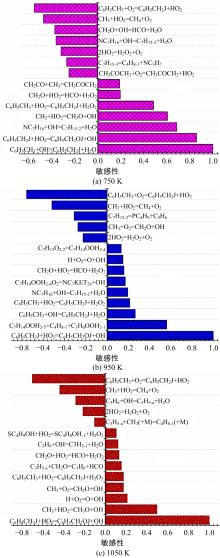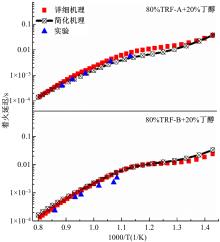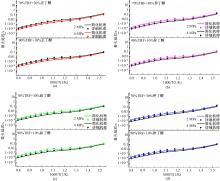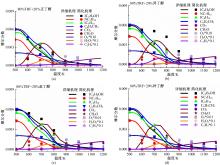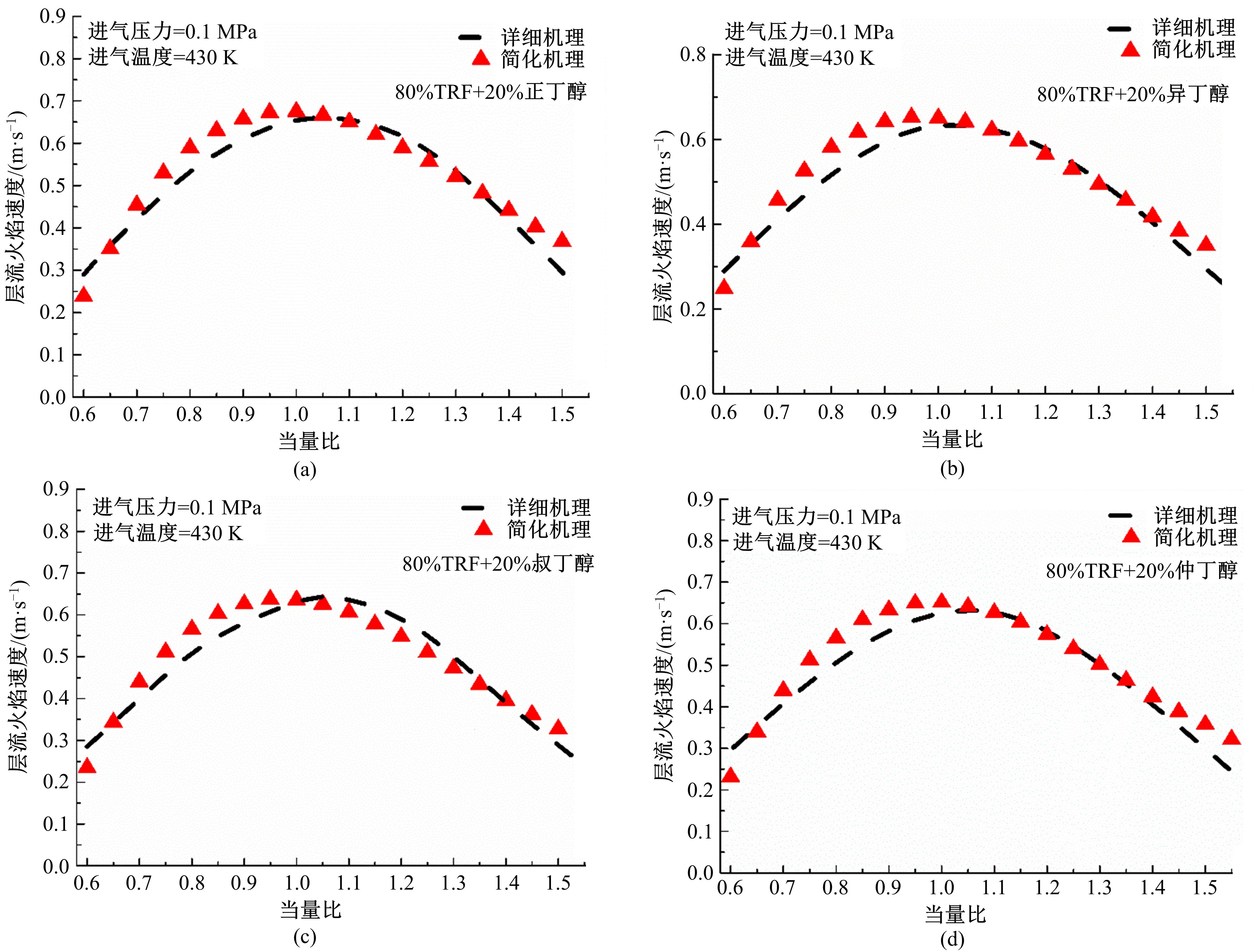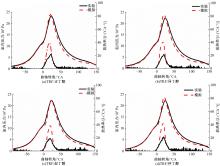Journal of Jilin University(Engineering and Technology Edition) ›› 2023, Vol. 53 ›› Issue (5): 1264-1271.doi: 10.13229/j.cnki.jdxbgxb.20210877
Development and validation of reduced combustion mechanism for gasoline/butanol blends
De-lin LYU1( ),Chao ZHOU1,Dong HAN1,2(
),Chao ZHOU1,Dong HAN1,2( )
)
- 1.Key Laboratory for Power Machinery and Engineering,Ministry of Education,Shanghai Jiao Tong University,Shanghai 200240,China
2.Shanghai Non-carbon Energy Conversion and Utilization Institute,Shanghai 200240,China
CLC Number:
- TK411
| 1 | 郭亮, 杨文昭, 王云开, 等. 废气再循环对丁醇/柴油混合燃料发动机的影响[J]. 吉林大学学报: 工学版, 2017, 47(6): 1767-1774. |
| Guo Liang, Yang Wen-zhao, Wang Yun-kai, et al. Effect of exhaust gas recirculation on internal combustion engine fueled with butanol/diesel blend[J]. Journal of Jilin University(Engineering and Technology Edition), 2017, 47(6): 1767-1774. | |
| 2 | 王乔, 孙万臣, 郭亮, 等. 丁醇/柴油混合燃料对压燃式发动机燃烧及微粒排放特征的影响[J]. 吉林大学学报: 工学版, 2019, 49(6): 1920-1928. |
| Wang Qiao, Sun Wan-chen, Guo Liang, et al. Effects of butanol/diesel blends on combustion and particulate emission characteristics of compression[J]. Journal of Jilin University(Engineering and Technology Edition), 2019, 49(6): 1920-1928. | |
| 3 | Kohse-Höinghaus K, Oßwald P, Cool T A, et al. Biofuel combustion chemistry: from ethanol to biodiesel[J]. Angewandte Chemie International Edition, 2010, 49(21): 3572-3597. |
| 4 | Stranic I, Chase D P, Harmon J T, et al. Shock tube measurements of ignition delay times for the butanol isomers[J]. Combustion & Flame, 2012, 159(2): 516-527. |
| 5 | Weber B W, Sung C J. Comparative autoignition trends in butanol isomers at elevated pressure[J]. Energy & Fuels, 2013, 27(3): 1688-1698. |
| 6 | Dagaut P, Sarathy S M, Thomson M J. A chemical kinetic study of n-butanol oxidation at elevated pressure in a jet stirred reactor[J]. Proceedings of the Combustion Institute, 2009, 32(1): 229-237. |
| 7 | Sarathy S M, Vranckx S, Yasunaga K, et al. A comprehensive chemical kinetic combustion model for the four butanol isomers[J]. Combustion and Flame, 2012, 159(6): 2028-2055. |
| 8 | Yusoff M N A M, Zulkifli N W M, Masjuki H H, et al. Performance and emission characteristics of a spark ignition engine fuelled with butanol isomer-gasoline blends[J]. Transportation Research Part D Transport and Environment, 2017, 57: 23-38. |
| 9 | Han D, Fan Y, Sun Z, et al. Combustion and emissions of isomeric butanol/gasoline surrogates blends on an optical GDI engine[J]. Fuel, 2020, 272: 117690. |
| 10 | Alramadan A S, Badra J, Javed T, et al. Mixed butanols addition to gasoline surrogates: shock tube ignition delay time measurements and chemical kinetic modeling[J]. Combustion and Flame, 2015, 162:3971-3979. |
| 11 | Fan Y, Duan Y, Liu W, et al. Effects of butanol blending on spray auto-ignition of gasoline surrogate fuels[J]. Fuel, 2020, 260: 116368. |
| 12 | Fan Y, Duan Y, Han D, et al. Influences of isomeric butanol addition on anti-knock tendency of primary reference fuel and toluene primary reference fuel gasoline surrogates[J]. International Journal of Engine Research, 2021, 22(1): 39-49. |
| 13 | 刘凯敏. 高速汽油机燃用丁醇汽油的性能及化学反应机理研究[D]. 长沙: 湖南大学机械与运载工程学院, 2018. |
| Liu Kai-min. Research on engine performance and chemical mechanism model of butanol-gasoline blends in high speed gasoline engine[D]. Changsha: College of Mechanical and vehicle Engineering, Hunan University, 2018. | |
| 14 | 王建军. 丁醇和汽油及丁醇汽油混合燃料在缸内直喷发动机中燃烧过程及排放特性的研究[D]. 合肥:合肥工业大学汽车与交通工程学院, 2014. |
| Wang Jian-jun. Experimental study on combustion process and emission characteristics in direct injection engine of butanol, gasoline and butanol-gasoline blends[D]. Hefei: College of Automobile and Transportation Engineering, Hefei University of Technology, 2014. | |
| 15 | Lu T, Law C K. A directed relation graph method for mechanism reduction[J]. Proceedings of the Combustion Institute, 2005, 30: 1333-1341. |
| 16 | Ra Y, Reitz R D. A reduced chemical kinetic model for IC engine combustion simulations with primary reference fuels[J]. Combustion and Flame, 2008, 155(4): 713-738. |
| 17 | Ra Y, Reitz R D. A combustion model for IC engine combustion simulations with multi-component fuels[J]. Combustion and Flame, 2011, 158(1): 69-90. |
| 18 | Mehl M, Pitz W J, Westbrook C K, et al. Autoignition behavior of unsaturated hydrocarbons in the low and high temperature regions[J]. Proceedings of the Combustion Institute, 2011, 33(1): 201-208. |
| 19 | Sarathy S M, OWald P, Hansen N, et al. Alcohol combustion chemistry[J]. Progress in Energy & Combustion Ence, 2014, 44: 40-102. |
| 20 | Reaction Design Inc. CHEMKIN-PRO, Release 15131[CP]. San Diego, CA: Reaction Design Inc, 2013. |
| 21 | Sun Z, Ma Z, Li X, et al. Study of flash boiling spray combustion in a spark ignition direct injection optical engine using digital image processing diagnostics[J]. Fuel, 2021, 284: 119078. |
| 22 | Han Z, Reitz R D. Turbulence modeling of internal combustion engines using RNG k-ɛ models[J]. Combustion Science and Technology, 1995, 106(4-6): 267-295. |
| 23 | Han Z, Reitz R D. A temperature wall function formulation for variable-density turbulent flows with application to engine convective heat transfer modeling[J]. International Journal of Heat & Mass Transfer, 1997, 40(3): 613-625. |
| 24 | Senecal P K, Pomraning E, Richards K J, et al. Multi-dimensional modeling of direct-injection diese liquid length and flame lift-off length using cfd parallel detailed chemistry[J]. SAE Transactions, 2003, 112: 1331-1351. |
| 25 | Beale J C, Reitz R D. Modeling spray atomization with the Kelvin-Helmholtz/Rayleigh-Taylor hybrid model[J]. Atomization and Sprays, 1999, 9(6):623-650. |
| [1] | Tong-bin ZHAO,Yi-sheng WU,Yao-zong DUAN,Zhen HUANG,Dong HAN. RP⁃3 jet fuel lubricity and improvement measurements [J]. Journal of Jilin University(Engineering and Technology Edition), 2022, 52(3): 533-540. |
| [2] | DENG Li-fei, SHI Yao-wu, ZHU Lan-xiang, YU Ding-li. Failure detection of closed-loop systems and application to SI engines [J]. 吉林大学学报(工学版), 2017, 47(2): 577-582. |
| [3] | Li Tielong, Liu Haishui, Jin Zhaohui, Kang Haiyan, Liu Zhenying, Wang Wei. Batch experiment on reduction of nitrate in water by nanoscale zero valent iron particles [J]. 吉林大学学报(工学版), 2006, 36(02): 264-0268. |
|
||
